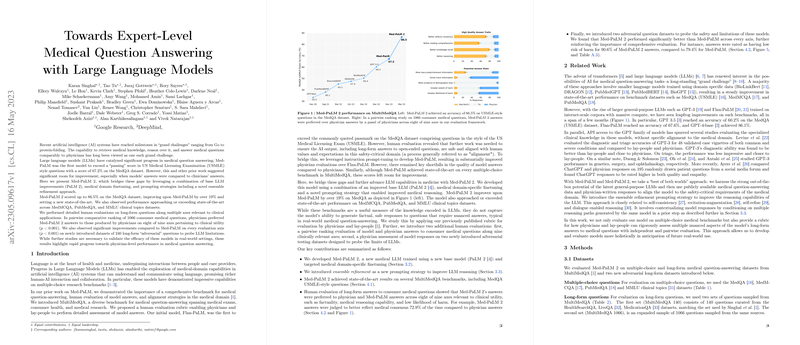Analyzing "Towards Expert-Level Medical Question Answering with LLMs"
The paper "Towards Expert-Level Medical Question Answering with LLMs" focuses on the development of Med-PaLM 2, an advanced LLM designed to improve the quality and reliability of medical question-answering. This research contributes to a significant incremental step in the deployment of AI in the medical field, specifically aimed at enhancing the performance of LLMs to approach the level of expertise demonstrated by human physicians. The paper outlines the methodologies employed, such as leveraging improved base LLMs, domain-specific finetuning, and novel prompting strategies, including ensemble refinement.
Key Achievements and Methodologies
Med-PaLM 2 builds upon the achievements of its predecessor, Med-PaLM, by incorporating an enhanced core model named PaLM 2. This model is subjected to targeted medical domain-specific finetuning, which is crucial in aligning its capabilities with the complex requirements of the medical domain. A notable feature of this model is the introduction of ensemble refinement, a prompting strategy designed to refine LLM reasoning by aggregating multiple reasoning paths generated by the model, thereby producing more accurate answers.
The model demonstrates a substantial improvement in performance on the MedQA dataset, used to simulate USMLE-style medical licensing exams, achieving a state-of-the-art score of 86.5%, a notable increase of 19% over the previous version. This illustrates the effectiveness of the methodological enhancements in bridging the gap between machine and human performance in medical question-answering tasks.
Evaluation and Results
The evaluation of Med-PaLM 2 spanned both multiple-choice and long-form questions. For the former, Med-PaLM 2 set new state-of-the-art performance levels across benchmarks like MedQA, PubMedQA, MedMCQA, and several clinical topics in the MMLU dataset. Highlighting its efficiency, Med-PaLM 2 outperforms other models like GPT-4-base in both 5-shot and specific ensemble refinement settings, illustrating its advanced inference capabilities.
The evaluation on long-form responses was pivotal in exploring the model’s applicability in real-world medical scenarios. Here, Med-PaLM 2's responses were often preferred over those authored by physicians across multiple dimensions of clinical utility, demonstrating not just factual accuracy but also superior medical reasoning capabilities. However, Med-PaLM 2's propensity to include trivial details over omitting critical content suggests an area of potential refinement to balance depth and succinctness in responses.
Challenges and Implications
Despite the advancements, the paper acknowledges ongoing limitations, such as the need for further external validation of model efficacy in practical, real-world medical contexts. While Med-PaLM 2 shows remarkable promise, it remains subject to challenges like ensuring the safety and ethical deployment of AI in healthcare, where the stakes involve patient well-being.
The implications are profound, pointing toward a future where AI systems can support healthcare professionals by delivering expert-level diagnostics and treatment guidance, potentially reducing the burden on medical practitioners.
Future Directions
The paper suggests that further enhancements in LLMs, especially concerning their alignment strategies and evaluation methodologies, will be critical in progressing towards widespread clinical acceptance. Future work may involve refining the models' ability to handle nuanced clinical scenarios with more empathy and less bias, advancing the development of models that not only emulate but also exceed human performance in many routine medical tasks.
In conclusion, "Towards Expert-Level Medical Question Answering with LLMs" is a significant contribution to AI in healthcare, showcasing how methodical improvements in model training and prompting strategies can markedly enhance performance in medical domains, bringing AI closer to expert human professionals.
